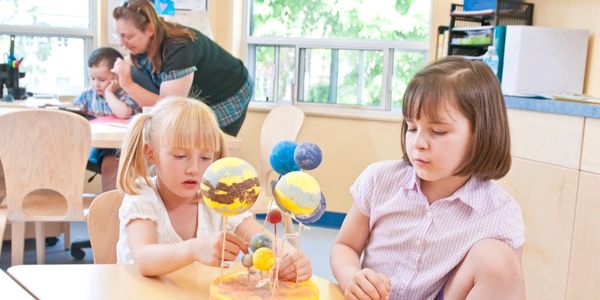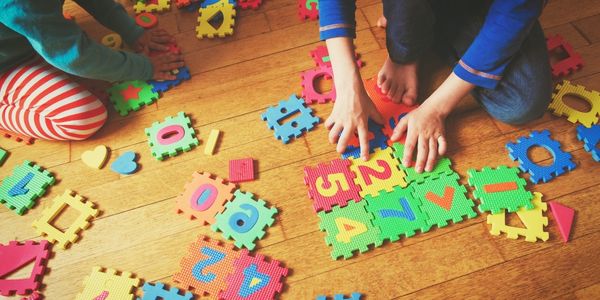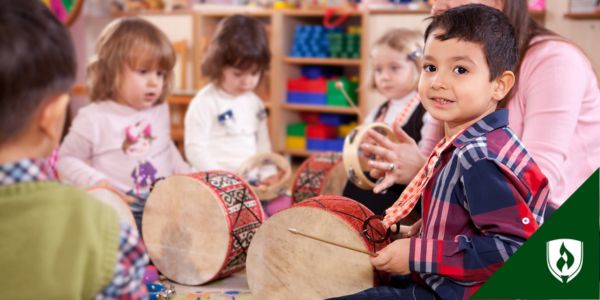What Is Waldorf Education? Exploring This Approach to Early Childhood Education
By Carrie Mesrobian on 07/26/2021
Early childhood education (ECE) is having a bit of a moment lately. The Biden Administration’s American Families Plan proposal and its inclusion of potential funding for preschool education has put the potential benefits of universal pre-K education into the national conversation. Early childhood education is a vast field, with a range of philosophies and traditions undergirding this vital time of human development. While there are a lot of overlapping themes and foundational elements found within these philosophies, it helps for future educators and parents to understand what these different approaches are about.

One prominent ECE approach is Waldorf® education. Like Montessori programs, Waldorf education is just one of many frameworks for education, beginning at preschool age and potentially continuing through high school. If you’ve ever wondered about the origins of Waldorf education and its place in the field of learning, read on.
What is Waldorf Education?
The first Waldorf School was founded in 1919 by Rudolf Steiner, an Austrian scientist and philosopher.1 While visiting the Waldorf Astoria cigarette factory in Stuttgart, Germany, Steiner spoke with the workers about their thoughts on what would improve their lives. At the time, Germany was dealing with the aftermath of the first World War, with social, economic and political disruption causing chaos throughout the nation. Steiner expressed the need for renewal to address these issues, prompting the factory owner to request a new school be established for his employees. The Independent Waldorf School was the result of this experience.
Steiner was a true “Renaissance man” in that he had studied many subjects widely, including spirituality, science, art, agriculture, economics and sociology.2 He believed that an integrated approach—melding spirit, soul and body—was the proper way to handle human development and enrich societal capacity.
Steiner’s philosophy, which he called anthroposophy, was based on holistically assembling “the knowledge produced by the higher self in man.”1 Because of this, Waldorf schools are arranged to be independently led and responsive to the needs of the children who attend them. Teachers trained as Waldorf instructors are taught to seek the inner motivations and passions of every student, creating a custom-built learning plan that is sensitive to the unique talents and preferences of every child.
Rebecah Freeling, a child behavior expert and parent coach at Wit’s End Parenting®, is a trained Waldorf teacher who ran a Waldorf preschool in Columbus, Ohio, for over a decade. What drew her to the Waldorf educational model was its individualized approach.
“The Waldorf teacher is taught to create the classroom and the curriculum around the children who are actually in the classroom,” Freeling explains. “For a lot of kids, it’s a super great model.”
Freeling found the teacher training to be extremely rewarding. “So fun, invigorating, inspirational,” Freeling recalls. “You learn some really interesting psychology; you learn that there’s a spiritual component to learning.”
Because Waldorf teachers are tasked with fitting their classroom and materials to fit the needs of every student, the opportunity for creativity is immense.
“You’re basically in charge of your own classroom,” Freeling explains. “There’s no textbook. For someone who’s not good at being an employee or taking orders, this is ideal.” Freeling found that freedom to bring her own “genius and energy, success and failure” into her instructional decision-making was exhilarating.
“You’re a teacher who is always asking what’s possible,” Freeling says.
Steiner’s model of education emphasized the four basic temperaments in all human beings: choleric, phlegmatic, melancholic and sanguine.3 Steiner believed everyone has one or two of these temperaments that are dominant. A Waldorf teacher’s job is to create a classroom that teaches to all these temperaments so that each child has a variety of methods for interacting socially and educationally. This method does not focus on labels but rather expanding a child’s repertoire of tactics as they proceed through their development.
A choleric temperament features intensity and quick action, especially toward making and doing. Natural leaders, children with this temperament enjoy difficult tasks and full engagement with projects. They are also quickly frustrated and easily impatient. A good example of a choleric temperament, says Freeling, is found in the bouncy, action-oriented Tigger®, from A.A. Milne’s Winnie the Pooh® stories.
The phlegmatic temperament, in contrast, is much more like Winnie the Pooh himself, explains Freeling. Happy-go-lucky, complacent, slow-paced and content to be alone, the phlegmatic temperament challenges the Waldorf teacher in finding activities that suitably motivate them.
Children with the melancholic temperament are similarly low energy as phlegmatics but tend toward morose and pessimistic moods. For reference, Freeling says this temperament is in line with Eeyore®. The melancholic temperament is one of deep thought and compassion, compelling Waldorf instructors to make space for sympathy and human emotion in classroom interaction.
The sanguine temperament can be seen in Piglet®, Freeling says. Extremely social, with difficulty concentrating at times, the sanguine temperament delights in being with others and learning all the latest news. Because they are naturally energetic and fond of variety and speed, the Waldorf instructor must work to balance these dynamic spirits into the classroom.
How do Waldorf principles fit in an early childhood education setting?
For Freeling, what makes an early childhood education classroom a Waldorf one is the emphasis on social interaction and play. “True play-based, relationship-based learning,” Freeling says. “We don’t start teaching reading and math until first grade.”
Delaying academic work in a Waldorf preschool in favor of play-based activities makes a solid foundation for learning math and reading. But even that is done unconventionally.
“It’s all artistically taught,” Freeling says. “And taught to various learning styles, with each lesson done in three to four different ways.”
One of the core questions a Waldorf instructor is trained to ask of each student is what their destiny is. “People have a destiny, knowing they want to accomplish something,” Freeling explains. “That’s really informative as a teacher: ‘You came to do something—what are you actually trying to do?’”
For this reason, every Waldorf preschool classroom looks unique. Beautiful, gorgeous classrooms, some of them outfitted with items many might believe out of place for young children, like ovens or woodworking tools. Waldorf preschools often feature gardens and outdoor play spaces where children are taught to grow and care for plants and animals. This fits with an essential Waldorf value: children are given plenty of time and space for exploring the world around them.
What types of challenges and advantages do Waldorf educators have?
Despite the dreamy qualities of a classroom equipped for the unique potential of each child, Waldorf schools are not without their challenges. A big challenge for many Waldorf schools is funding. Generally, Waldorf schools are private, nonprofit entities. Tight budgets can have a cascading effect on pay and the overall stability of a school following this model.
“They can be notoriously hard to fund,” Freeling says of Waldorf schools.
Another issue is the model on which Waldorf schools are administrated, which is historically supposed to be teacher-led.
“Some schools have figured it out by hiring an administrator,” Freeling explains. “Some have teachers do the administration, which can be overwhelming. You have to be sure going in how much you want to commit.”
Freeling herself brought woodworking tools into her classroom as a response to a child who was extremely strong-willed and violent and who had been expelled from several other schools prior to enrolling at Freeling’s.
“I’m supposed to be able to connect with students by being soft and loving and nurturing,” Freeling recalls of the experience. “And it wasn’t working.”
Freeling remembers asking herself regarding this boy, “What are you trying to do?” The answer?
“He’s trying to make an impact,” Freeling says. “He wants to be seen; he wants to contribute something that’s a big deal.”
When Freeling gave the boy woodworking tools—“real saws and hammers, nails, two-by-fours”—she discovered the right activity for his temperament.
“I started removing toys from the classroom,” Freeling continues. “When the kids asked where they’d gone, I’d tell them to go ask the boy to build them new ones.” Soon, the other children started coming up to the student with requests for new toys or for repairs to old ones.
“By the time he was six, he was large and in charge,” Freeling said. The power he’d shown previously in hurting people or breaking things was transformed into leadership and purpose.
Despite this successful outcome, Freeling reports that many Waldorf schools often do not consider a challenging temperament a “good fit.” Instead of shifting their program to meet the temperaments of the students, they decide certain students aren’t a good match.
Freeling sees this as a tremendous loss as she’s gone on to work with parents with temperaments much like the boy she taught woodworking.
“The children themselves are the biggest influence in the classroom,” Freeling says. “It’s not just about how to teach math in a cute way but how to influence children in a positive way that impacts their life forever.”
Learn more about early childhood education
Thinking about how you might impact the lives of young children? No matter the style of education you apply yourself to, it helps to have a solid foundation of understanding child development. Our article “Is a CDA Credential Worth It” explores the value of one common education credential in the field of early childhood education.
Related Articles:
1“Rudolf Steiner” Encyclopedia Britannica Online. March 26, 2021 [accessed June, 2021] https://www.britannica.com/biography/Rudolf-Steiner
2Christopher Bamford and Eric Utne, “Rudolf Steiner and the History of Waldorf Education” Association of Waldorf Schools of North America. [accessed June, 2021] https://www.waldorfeducation.org/waldorf-education/rudolf-steiner-the-history-of-waldorf-education
3“Temperaments in a Waldorf School” Waldorf Publications. August 18, 2015 [accessed June, 2021] https://www.waldorfpublications.org/blogs/book-news/40270145-temperaments-in-a-waldorf-school
Winnie the Pooh, Tigger, Eeyore and Piglet are registered trademarks of Disney Enterprises, Inc.
Waldorf is a registered trademark of the Association of Waldorf Schools of North America, Inc.
Wits End Parenting is a registered trademark of Wits End Parenting, Inc.




